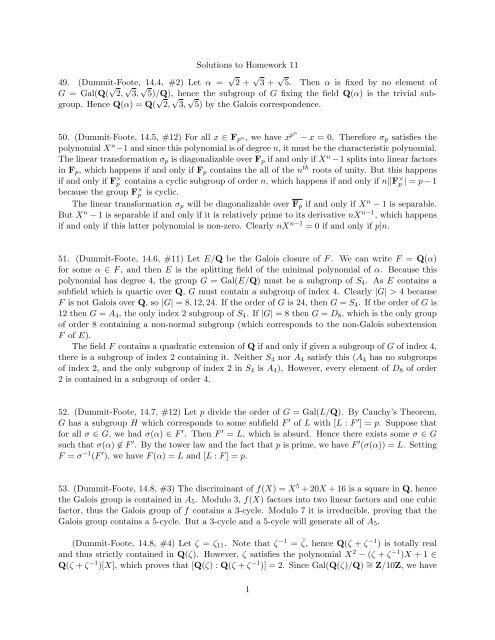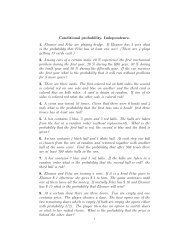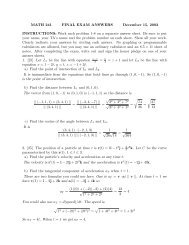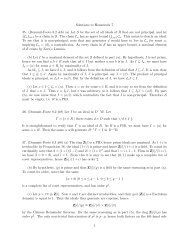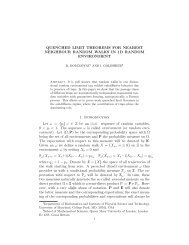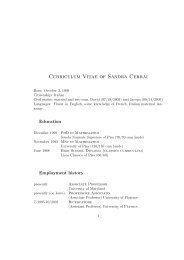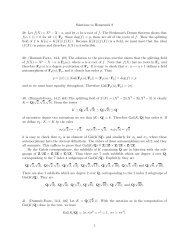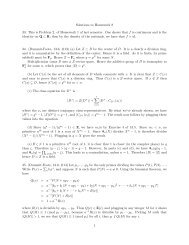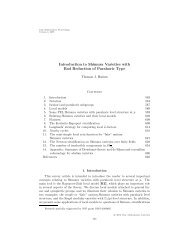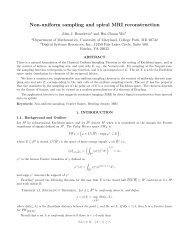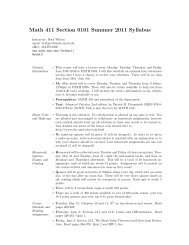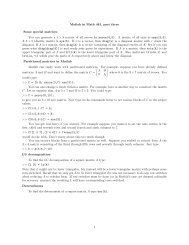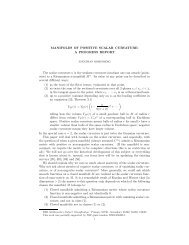Solutions to Homework 11 49. (Dummit-Foote, 14.4, #2) Let α = â 2 ...
Solutions to Homework 11 49. (Dummit-Foote, 14.4, #2) Let α = â 2 ...
Solutions to Homework 11 49. (Dummit-Foote, 14.4, #2) Let α = â 2 ...
Create successful ePaper yourself
Turn your PDF publications into a flip-book with our unique Google optimized e-Paper software.
<strong>Solutions</strong> <strong>to</strong> <strong>Homework</strong> <strong>11</strong><br />
<strong>49.</strong> (<strong>Dummit</strong>-<strong>Foote</strong>, <strong>14.4</strong>, <strong>#2</strong>) <strong>Let</strong> α = √ 2 + √ 3 + √ 5. Then α is fixed by no element of<br />
G = Gal(Q( √ 2, √ 3, √ 5)/Q), hence the subgroup of G fixing the field Q(α) is the trivial subgroup.<br />
Hence Q(α) = Q( √ 2, √ 3, √ 5) by the Galois correspondence.<br />
50. (<strong>Dummit</strong>-<strong>Foote</strong>, 14.5, #12) For all x ∈ F p n, we have x pn − x = 0. Therefore σ p satisfies the<br />
polynomial X n −1 and since this polynomial is of degree n, it must be the characteristic polynomial.<br />
The linear transformation σ p is diagonalizable over F p if and only if X n −1 splits in<strong>to</strong> linear fac<strong>to</strong>rs<br />
in F p , which happens if and only if F p contains the all of the n th roots of unity. But this happens<br />
if and only if F × p contains a cyclic subgroup of order n, which happens if and only if n||F × p | = p − 1<br />
because the group F × p is cyclic.<br />
The linear transformation σ p will be diagonalizable over F p if and only if X n − 1 is separable.<br />
But X n − 1 is separable if and only if it is relatively prime <strong>to</strong> its derivative nX n−1 , which happens<br />
if and only if this latter polynomial is non-zero. Clearly nX n−1 = 0 if and only if p|n.<br />
51. (<strong>Dummit</strong>-<strong>Foote</strong>, 14.6, #<strong>11</strong>) <strong>Let</strong> E/Q be the Galois closure of F . We can write F = Q(α)<br />
for some α ∈ F , and then E is the splitting field of the minimal polynomial of α. Because this<br />
polynomial has degree 4, the group G = Gal(E/Q) must be a subgroup of S 4 . As E contains a<br />
subfield which is quartic over Q, G must contain a subgroup of index 4. Clearly |G| > 4 because<br />
F is not Galois over Q, so |G| = 8, 12, 24. If the order of G is 24, then G = S 4 . If the order of G is<br />
12 then G = A 4 , the only index 2 subgroup of S 4 . If |G| = 8 then G = D 8 , which is the only group<br />
of order 8 containing a non-normal subgroup (which corresponds <strong>to</strong> the non-Galois subextension<br />
F of E).<br />
The field F contains a quadratic extension of Q if and only if given a subgroup of G of index 4,<br />
there is a subgroup of index 2 containing it. Neither S 4 nor A 4 satisfy this (A 4 has no subgroups<br />
of index 2, and the only subgroup of index 2 in S 4 is A 4 ). However, every element of D 8 of order<br />
2 is contained in a subgroup of order 4.<br />
52. (<strong>Dummit</strong>-<strong>Foote</strong>, 14.7, #12) <strong>Let</strong> p divide the order of G = Gal(L/Q). By Cauchy’s Theorem,<br />
G has a subgroup H which corresponds <strong>to</strong> some subfield F ′ of L with [L : F ′ ] = p. Suppose that<br />
for all σ ∈ G, we had σ(α) ∈ F ′ . Then F ′ = L, which is absurd. Hence there exists some σ ∈ G<br />
such that σ(α) ∉ F ′ . By the <strong>to</strong>wer law and the fact that p is prime, we have F ′ (σ(α)) = L. Setting<br />
F = σ −1 (F ′ ), we have F (α) = L and [L : F ] = p.<br />
53. (<strong>Dummit</strong>-<strong>Foote</strong>, 14.8, #3) The discriminant of f(X) = X 5 + 20X + 16 is a square in Q, hence<br />
the Galois group is contained in A 5 . Modulo 3, f(X) fac<strong>to</strong>rs in<strong>to</strong> two linear fac<strong>to</strong>rs and one cubic<br />
fac<strong>to</strong>r, thus the Galois group of f contains a 3-cycle. Modulo 7 it is irreducible, proving that the<br />
Galois group contains a 5-cycle. But a 3-cycle and a 5-cycle will generate all of A 5 .<br />
(<strong>Dummit</strong>-<strong>Foote</strong>, 14.8, #4) <strong>Let</strong> ζ = ζ <strong>11</strong> . Note that ζ −1 = ¯ζ, hence Q(ζ + ζ −1 ) is <strong>to</strong>tally real<br />
and thus strictly contained in Q(ζ). However, ζ satisfies the polynomial X 2 − (ζ + ζ −1 )X + 1 ∈<br />
Q(ζ + ζ −1 )[X], which proves that [Q(ζ) : Q(ζ + ζ −1 )] = 2. Since Gal(Q(ζ)/Q) ∼ = Z/10Z, we have<br />
1
Gal(Q(ζ + ζ −1 )/Q) ∼ = Z/5Z. Now, the given polynomial is of degree 5 and is satisfied by ζ + ζ −1 ,<br />
which proves the result.<br />
2


